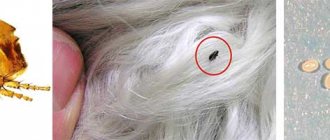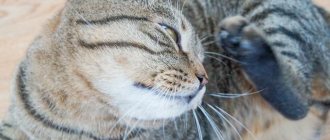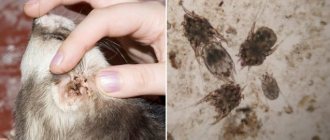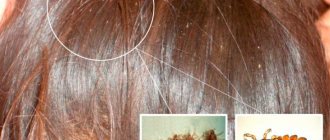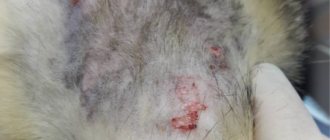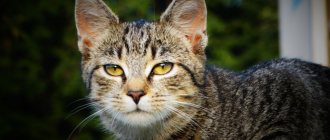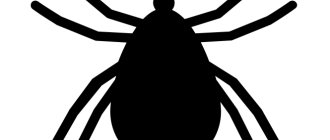A louse is a specific human parasite that feeds on human blood and does not live on anyone else. People cannot become infected with these insects from cats or dogs. But domestic animals also have parasites, which are called lice because of their similarity to the human head louse in appearance and lifestyle.
Lice in cats are called lice eaters. These insects attack the fur and skin of cats and cause a lot of pain. They differ from fleas: they cannot jump and are generally inactive. They live only on cats; if they get on other animals or humans, they die. Likewise, human lice do not live on cats.
How are cat lice different from human lice?
The main difference between lice is their diet. The human louse feeds on blood, while the cat louse feeds on particles of skin and fur. She chews off pieces of the animal's skin with her sharp jaws, leaving wounds that itch and bother the cat. The louse does not purposefully drink blood, but it can also feed on it from the surface of the skin if it encounters a wound along the way. It cannot pierce the skin like a human louse.
Lice that live on cats are not dangerous to humans. But these parasites carry eggs of different types of worms, so they can be dangerous for children and people with low immunity. If you pet an infected animal and then do not wash your hands, you can simply introduce the pests into your mouth.
Prevention
Regular inspection and treatment with anti-parasite products will protect your cat from lice, ticks, and fleas. Using a special collar will also help. To select the size, measure the diameter of the cat's neck. The collar is selected so that it fits tightly on the animal without causing discomfort.
If it is too loose, the cat will cling to various objects with it during street walks. This will increase the risk of injury.
A tight collar puts pressure on the animal's neck. The cat tries to remove it and may injure itself.
The collars are impregnated with special components that not only repel lice, fleas or ticks, but also kill existing parasites. They can also be used as a method of treatment.
The active components of the collar have a limited lifespan. Usually it ranges from six months to eight months. Don't forget to change your protective equipment on time.
If you use the services of cat groomers, choose your groomer carefully. Feel free to ask how he handles the tools. It is advisable that they be disinfected in front of you. This will protect your pet not only from lice, but also from some cat infections.
Used brushes, slicker brushes, combs, and cat bedding received as a gift must be disinfected. Wash them with a special product, wash the textiles at high temperature.
Lice cause a lot of problems for both the animal and its owner. Therefore, you should not neglect the seasonal processing of the animal. And the best protection against uninvited “guests” will be anti-parasite collars.
What do lice look like on a cat?
Cat lice are similar to human lice. They have an oblong body with a triangular head and powerful mouthparts. Body light yellow. The paws are short, underdeveloped, adapted for moving along a cat's fur. This is one of the main differences between fleas and lice - fleas have powerful hind legs that allow them to jump.
In their development, lice eaters do not pass through the pupa and nymph stages. Like human lice, they lay eggs called nits. The nits hatch into individuals similar to adults, but smaller in size. The life cycle of the lice eater is up to 4 weeks. During this time, the female can lay 60–70 eggs. Nits are oblong, hard, and are glued to the animal’s fur with thick mucus. They are quite noticeable.
Pathogens
Dogs are most often parasitized by canine, cat and human fleas. Adult insects are wingless, the body is strongly compressed laterally, the legs are strong, long, with numerous spines, the antennae are short, club-shaped, hidden at rest in recesses on the sides of the head. The mouthparts are adapted for piercing the skin and sucking blood. Fleas are small insects with a body usually not exceeding 2-4 mm in length.
The pathogen has ctenidia on the lower edge of the head and on the posterior edge of the anterior thoracic segment (a row of spines in the form of a comb-like formation with points directed backwards), consisting of 7-9 spines, with the first spine in the head row and the lower spine in the thoracic row of the ctenidium being shorter than the others .
Biology
Fleas are temporary parasites. Female fleas lay very small, oval, whitish eggs, dropping them (non-sticky eggs) onto the host, from where they can roll onto the litter, ground, or floor. After 1-2 weeks, under favorable conditions, larvae with a thin worm-like body emerge from the eggs, leading a free lifestyle and feeding on decaying organic matter and food residues. After a few days, the larvae pupate in a cocoon. After 12 days, an adult flea emerges from the pupa, leading a parasitic lifestyle.
Males and females suck blood. Capable of long-term fasting (up to 18 months) outside the host’s body.
Where do cat lice come from?
Lice eaters can appear in any cat except hairless ones. Long-haired pets are especially affected by them. There is a greater risk of contracting lice from outdoor cats, but indoor cats can also become infected.
Routes of infection:
- contact with another animal that carries lice on the street or staircase;
- in a veterinary clinic, grooming salon;
- the owner may bring in cat lice on clothes and shoes.
Lice in cats are not very mobile, but if necessary, they can travel some distance not only along fur, but also on other surfaces. On an animal, they prefer to settle in areas with the most delicate skin and short, soft hair - on the head, back of the head, and near the tail.
Treatment
Lice are easily killed by insecticides, so getting rid of them is usually not difficult. If the pet is kept in an apartment, it is washed with anti-parasitic shampoo (for example, Lugovoi), and after 3 days, a flea and tick drug in the form of drops is applied to the withers or an insectoacaricidal collar is put on. When washing, contact of foam with wool and skin should be 5-7 minutes.
For kennel dogs or aggressive cats, they are limited to applying spot-on preparations (“Bars”, “Bars Forte”) to the skin. This is enough to kill insects. You can use insectoacaricides in spray form.
Since the shell of eggs (nits) is very durable and not all insecticides penetrate through it, preference should be given to long-acting preparations.
Lice and lice more often affect young animals, and when choosing a drug, you need to take into account not only the body weight, but also the age of the animals. Bars Forte drops for puppies and kittens are approved for use from 10 weeks of age.
If small puppies or kittens, pregnant or malnourished animals are infected with lice, your veterinarian will recommend a special remedy. You need to get rid of parasites in any case, but it is important to avoid side effects from insectoacaricides.
If an outbreak of trichodectosis or siphunculatosis occurs in a nursery or shelter, it is rational to use a product that is suitable for treating not only the animals themselves, but also the premises - “Delcid”. It is an insectoacaricide from the pyrethroid group.
Before use, consult a veterinarian.
Symptoms of infection
Lice in cats often appear simultaneously with fleas, but they can infect a pet on their own. The following signs may indicate that a cat has pediculosis, or more precisely siphunculatosis (this is what infestation with lice eaters is called):
- severe itching - lice bite off pieces of skin, constantly injure the cat and cause it to itch continuously;
- the appearance of bleeding wounds, abrasions, scratches - both from bites and from scratching;
- shedding - the animal begins to shed its fur, and this is not similar to seasonal shedding: bald spots appear in certain places;
- upon careful examination, you can see accumulations of insects, their excrement, remains of shells, and nits;
- anxiety - the cat behaves unnaturally, constantly itches, rubs itself on its legs and furniture, sleeps poorly, etc.
It is possible to defeat parasites!
Antiparasitic Complex® - Reliable and safe removal of parasites in 21 days!
- The composition includes only natural ingredients;
- Does not cause side effects;
- Absolutely safe;
- Protects the liver, heart, lungs, stomach, skin from parasites;
- Removes waste products of parasites from the body.
- Effectively destroys most types of helminths in 21 days.
There is now a preferential program for free packaging. Read expert opinion.
Read further:
Deworming drops for cats: list of the best drugs, how to use, price and reviews
Advocate against worms and fleas for cats and dogs: instructions for use, price, reviews
No to ticks: where to order insect repellent treatment?
What do lice eat on the human body, the lifestyle of parasites
Long worms in cats: main types, description and methods of treating parasites in cats
Vetom 1 for cats: instructions on how to give the drug to a cat, reviews and description
How dangerous are lice for cats?
In addition to debilitating itching, lice in cats can cause the following problems:
- hair loss up to total baldness;
- infection of wounds from vinegar leads to the development of dermatitis and eczema;
- in particularly advanced cases, infections from wounds enter the bloodstream and can cause more complex diseases;
- lice eaters are carriers of worm eggs.
If lice are not removed, this can develop into other diseases and ultimately lead to exhaustion and death of the animal.
How to avoid lice infection
To protect yourself and your loved ones from harm, you need to follow several rules in your life:
- Do not use other people's personal hygiene items.
- Do not wear other people's clothing or try on hats.
- While washing your hair, add a few drops of tea tree essential oils. The smell repels lice. And for prevention it is an excellent remedy.
- Do not swim in bodies of water with many people. Especially if they are closed.
- Check your children's heads.
- Frequent itching should be a concern.
Nowadays, lice are not so much a dangerous phenomenon as they are a nuisance. If discovered, do not panic. If done correctly, they will appear fairly quickly. The main thing is to react in time. Take care of yourself and your hair.
How to get rid of lice from a cat
If you are not sure whether your pet has lice, contact your veterinarian. A specialist will accurately determine the type of parasite during a visual inspection. It can also make a differential diagnosis by taking a scraping from the animal's skin. The veterinarian will recommend a product to kill parasites, as well as a drug to treat skin problems if the cat already has them due to lice.
Folk remedies
You can use folk remedies to treat your cat for lice. This could include swimming in salt water. A kilogram of salt is diluted in 10 liters of water. The cat is bathed in this bath so that the salt water saturates the fur and is absorbed into the skin. The method should not be used if there are wounds, since salt irritates them very much. The solution is not washed off after the bath; the animal is thoroughly combed to remove parasites and nits.
Another way is to treat the animal’s body with a decoction of wormwood (20 grams of dry herb per half liter of water, boil for 20 minutes) or infusion of garlic (6 cloves per 0.6 liter, leave for 12 hours).
Shampoo
Special insecticidal products for animals are produced in the form of shampoos. Products that are used against fleas, ticks and other pests are effective against lice. They all operate on the same principle: they paralyze insects, causing their death. Shampoo is the most gentle remedy for lice in cats. You need to bathe the animal with it and then comb it to remove parasites from the fur. Sometimes one procedure is enough, but it is worth repeating the treatment after a few days. Shampoo may contain softening and healing substances, and components that care for the coat.
Many shampoos can be used for kittens from 4, 6 or 10 months of age. For kittens younger than this age, there is only one way to fight it - combing. But their fur is thin, easily visible, and the affected area is not too large, so it can be dealt with in several approaches.
Spray and drops
In serious cases of cat infestation with lice and when bathing with shampoo is not possible, insecticides are used in the form of a spray or drops. They are applied to the withers. These products act very quickly and retain their protective effect for several weeks or even months. The main thing is to prevent the cat from licking this product from the fur, but doing this from the withers is very difficult. It is better to carry out processing outdoors. The animal is not bathed for several days before and several days after. After 2 weeks you can re-treat.
Collars
To prevent lice infestation, it is recommended to purchase special collars for free-ranging animals. They can even be used on kittens from birth. But it is worth considering that the pungent odor and toxic insecticides in the composition can cause an allergic reaction.
The danger of lice and lice for cats and dogs
Lice and lice-eaters themselves are not very dangerous, but the consequences of their parasitism can be very serious.
- Cucumber tapeworm infection
. Like fleas, cat and dog lice eaters are intermediate hosts of tapeworms. An animal becomes ill by swallowing an infected insect while biting it. Young children who are in close contact with pets can become infected with cucumber tapeworm. - Severe exhaustion
. Due to itching, animals cannot rest and eat normally and become nervous. Puppies and kittens become weaker, lose weight, and lag behind in growth and development. Infected dogs may experience anemia due to the high number of bites. - Secondary skin problems
. Inflammation of the skin and self-injury during scratching cause secondary pyoderma (reproduction of pyogenic microflora). A complex of allergic reactions to parasite bites leads to severe dermatoses. - Infectious diseases.
There are few of them, they are rare, but they are especially dangerous (for example, tularemia).
Which drugs to choose
The market for veterinary drugs is saturated with drugs against cat lice. You can choose based on price, manufacturer, shape, composition. Products based on cypermethrin and permethrin are effective. You can buy, for example, Ectometrin from Medilis. Ectometrin is an insectoacaricidal (antiparasitic) agent intended to combat lice, fleas, lice eaters, lice beetles, skin beetles, flies, sarcoptic, ixodid, and chicken mites parasitic on animals (dogs, cats, fur-bearing animals, cattle, pigs, horses, goats , sheep) and poultry (chickens, geese, ducks), as well as for disinsection and decontamination of livestock buildings. The main thing when choosing and using any product is to strictly adhere to the instructions. And on the website you can always use the Ectometrin “working solution” calculator.
Danger to humans
Many pet owners worry that cat lice can be transmitted to humans and spread among family members. Therefore, first things first.
Do people get bitten?
The mouthparts of cat lice cannot bite the skin. Therefore, this type of parasite is not dangerous for humans.
Is it transmitted from cat to person?
Cat lice cannot be transmitted to humans because their paws cannot remain in human hair and skin. Moreover, without a power source, they quickly die. Therefore, humans cannot be infected with cat lice.
Are human lice transmitted to cats?
Similar to the previous one, you can also answer the question: are lice transmitted from humans to cats.
Human lice are able to fully develop and reproduce only at a certain body temperature. They also feed on human blood and are not infectious to cats.
Determining the type of pest
Jumping insects can be easily identified by their characteristic dark brown hue and dense body, which is almost impossible to crush. You will notice how such a parasite jumps, quickly disappearing from your view.
Flea species are classified according to the type of prey they parasitize. The most dangerous are rats, which carry a huge number of dangerous diseases, including plague. The peculiarity is that fleas do not disdain other victims, so the feline type can bite people without any problems.
If you notice that your cat is itching, you should immediately determine the type of parasitic disease. Most often, fleas and lice live in a kind of tandem, so it is quite difficult to distinguish insects on fur. The length of the sucker does not exceed 3 mm, and lice can grow up to 5 mm. The lifespan of an adult from the moment it emerges from a nit is 40 days. During such a period of time, the pest manages to cause enormous harm to the animal and lay many new eggs. If you don’t know what lice look like, then focus on the size of the insect and its proximity to the surface of the epithelium.
The most obvious sign of a pest on an animal is nits. This is the name given to the eggs that lice lay. From the moment of birth until death, insects are in the fur of their victim and actively reproduce. A special adhesive substance tightly attaches the nit in the shell to the hair, so it will be especially difficult to even tear it off with your nails. You don’t even need to look at photographs to see what lice and nits look like. You will immediately notice parasite eggs on your pet's fur during routine grooming.
Small nits will be much more noticeable than lice on cats. With a high degree of infestation and a large number of eggs laid, it will look as if the pet’s fur is sprinkled with grains. Lice are especially mobile and try to spend all their time close to the epithelium and out of sight of humans. At first you may think that your cat has dandruff, but then you will see unusual oblong-shaped capsules that do not exceed 1 mm in size.
